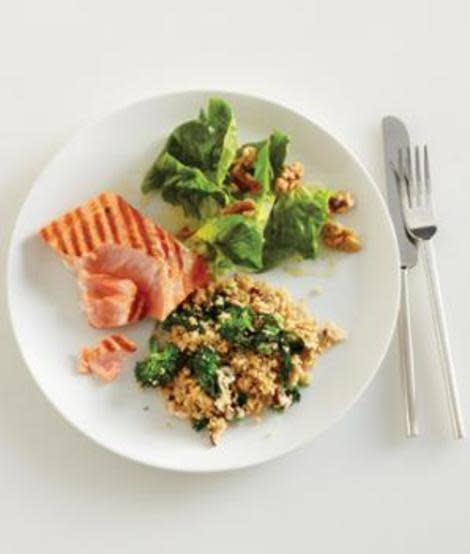Protein, Fats, and Carbs: What Should Really Be on Your Plate

Quick, what's the best way to lose weight and stay healthy? Drastically cut carbs, go very lowfat, become a vegan, or simply count calories? With all the conflicting advice these days about what you should be eating, it's hard not to have diet whiplash. A recent avalanche of news, however, is finally all pointing in the same direction-toward a moderate, eminently doable regimen that divides your daily intake evenly among three food groups: carbohydrates, protein, and fats.
RELATED: 10 Foods That Cause Inflammation
One recent study from the Norwegian University and Technology found that when people who had been eating a higher-carb, lower-protein diet were put on a balanced-ratio plan, they showed positive changes in their DNA that may translate into less inflammation in the body-which can reduce your risk for heart disease, cancer, and other chronic diseases.
At the same time, a growing body of research suggests that eating this way might also be a simple shortcut to losing pounds faster-and that getting enough protein in particular is key. "Protein, fat, and carbs work with each other to promote a greater sensation of satisfaction," explains New York City-based nutritionist Bonnie Taub- Dix, R.D., author of Read It Before You Eat It. "When you skimp on one group like protein, you tend to compensate by overeating something else you don't need any more of, like additional carbs or fat." A recent study in the journal PLoS ONE confirmed that pattern. When people lowered their daily intake of protein by as little as 5 percent and made up the difference with carbohydrate-rich foods, they consumed an additional 260 calories a day. They told researchers they felt hungrier, especially in the morning, and ended up snacking more frequently throughout the day.
RELATED: Change One Word, Lose Weight Faster
To get the right mix of foods in your meal, Taub-Dix advises concentrating on the quality of the foods, rather than stressing over the exact quantities. "When you fill your plate with a balanced medley of nutrient-rich foods, you'll end up feeling physically and emotionally satisfied," she says. Opt for complex carbs (quinoa, oatmeal, brown rice, veggies), lean meats and legumes (chicken, turkey, almond butter,beans), and sources of healthy fats rich in omega- 3s (salmon, avocados, walnuts, olive oil), and you'll find yourself naturally striking the right symmetry.
More on SHAPE:
10 Foods You Should Always Have in Your Foods
The Worst Drinks for Your Body
Food Bloggers Reveal: "The Weirdest Food I Ever Tried"